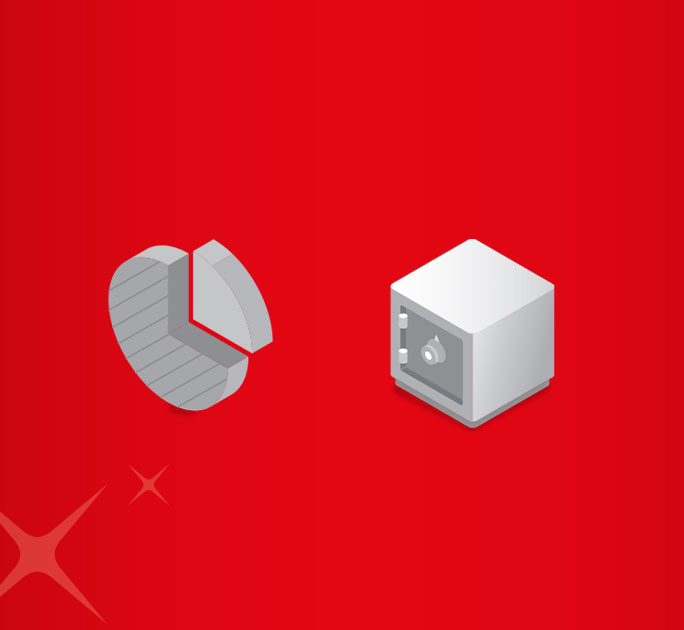- Save
- Invest
- Borrow
- Pay
- More
- NRI Banking
- Customer Services

TDS on FD Interest - How Much Tax is Deducted on FD?
Learn all about what is TDS on Fixed Deposits and the applicable tax rates.
Key Takeaways
- A fixed deposit is a low-risk investment option.
- The money is locked in for a fixed term and you can earn interest on it.
- This FD interest income is fully taxable.
- At the time of payment of this interest, banks and lenders deduct a 10% tax.
- This is called tax deducted at source, and is levied by the lenders at a flat rate.
- This TDS is part of your overall tax liability under the Income Tax Act, 1961.
Introduction: TDS on Fixed Deposits
Fixed deposits have traditionally been a preferred savings tool among Indians. People put their money into fixed deposits (FDs) to earn interest income on it. In simple words, a fixed deposit is an investment option where you can deposit a certain sum of money in a bank for a specified period of time and earn interest on the same. The interest rates offered on FDs varies from lender to lender.
Fixed deposits (also called term deposits) are seen as a safe bet by many who wish to invest their money and earn extra income on it, without taking too much risk. In case of FDs, you get an insurance coverage of up to INR 5 lakh. This is like a safety net in the event that a bank collapses due to financial duress, and the guarantee is provided by the Deposit Insurance Guarantee Corporation of India (DIGCI). Like with all your income sources, you have to pay TDS on fixed deposits too. In this article, we shall attempt to understand the concept of TDS on FD.
What is TDS on fixed deposits?
- The interest income from an FD is fully taxable. Interest earned on FDs is taxed according to the income bracket (and hence, the tax slab) you fall under.
- At the time of depositing this interest into your account, banks and lenders deduct a tax at a flat rate of 10%. This is called tax deducted at source (TDS).
- The TDS on fixed deposit is applicable only if the interest earned on an FD in a financial year exceeds INR 40,000. This threshold amount is INR 50,000 in the case of for senior citizens.
How is TDS Calculated on Fixed Deposit (FD) Interest?
TDS (Tax Deducted at Source) is calculated on the interest earned or paid on a Term Deposit within a financial year, following the guidelines set by the Income Tax Department. When your bank credits the interest to your account, TDS is deducted immediately. Here are some key points regarding tax on Fixed Deposits (FDs):
- If your total annual income is less than Rs 2.5 lakh, your bank won't deduct tax on your Fixed Deposit. However, you may need to submit Form 15G or 15H to avoid TDS.
- To prevent TDS, ensure you submit Form 15G or 15H to your bank at the start of the financial year.
- Interest income up to Rs 40,000 from all FDs in a year is exempt from TDS.
- If your interest income exceeds Rs 40,000, TDS is 10%. Without a PAN card, the bank may deduct 20% TDS.
What are the Different TDS Rates on FD Based on Your Residency Status?
There are different rates of TDS on FD interest applicable based on whether you are a resident Indian or a non-resident Indians (NRIs). They are as under:
- For Resident Indians: 10%
- For Non-Resident Indians: 30% (plus applicable surcharge and cess)
Moreover, if you are unable to furnish your PAN Card, the bank deducts TDS at a rate of 20% (for resident Indians).
What is the exemption limit for TDS deduction on an FD?
The exemption limit for TDS deduction on an FD depends on your age and total taxable income:
- Individuals below 60 years: The exemption limit is Rs. 40,000 per financial year. Meaning, if the interest earned on an FD is less than Rs. 40,000, TDS will not be deducted.
- Senior citizens (60 years and above): Similarly, for senior citizens, the exemption limit on FD interest income is Rs. 50,000 per financial year.
- Individuals with total taxable income below Rs. 2.5 lakhs: There is complete exemption from TDS on the interest income you earn on FD.
Should your interest income surpass the exemption threshold, TDS will be subtracted at the going rate, which is at 10%. If, however, your total taxable income is less than the designated thresholds, you can avoid TDS by filing Form 15G or 15H.
How to apply for a waiver on your TDS on FD?
You need to know the following to apply for a waiver on your TDS on FD.
- If you fall under the tax-exempt category, i.e., your total income is less than INR 2.5 lakh per year, you can seek a TDS waiver by submitting a Form 15G/15H right at the start of the year.
- If you are unable to submit these forms, you can still claim a TDS refund at the time of filing your year-end tax returns.
- There are also some ways to save on tax on FDs. A post office FD is one way as it does not attract any TDS deduction.
- You can divide the amount and put the money into fixed deposits in the name of your spouse or other family members. This is to try and keep the interest income under the INR 40,000 threshold.
- You should also know that if the TDS on FD deducted by the bank is more than your overall income tax liability, then you can claim a refund at the time of filing your ITR.
- The TDS deducted on interest income from FDs is thus a part of your total tax liability under the Income Tax Act.
What is Form 15G and 15H?
Form 15G and 15H are forms submitted by individuals to their bank to claim exemption from Tax Deducted at Source (TDS) on their fixed deposit interest income.
- Form 15G
This form is used by individuals below 60 years of age whose total taxable income is below the prescribed limit.
- Form 15H
This form is used by senior citizens (60 years and above) whose total taxable income is below the prescribed limit.
TDS on FD with an example
If you are under 60 years of age and your total taxable income is Rs. 4 lakhs, TDS (Tax Deducted at Source) will not be applied to your FD interest income as long as the interest earned is Rs. 40,000 or less in a financial year. However, if your interest earnings exceed Rs. 40,000, TDS will be deducted at the current rate of 10% on the entire interest amount.
Final Note
As is apparent from the above article, you have to pay TDS on FD interest income. If you are eligible for waivers on FD TDS, ensure that you submit the relevant 15G/H form at the beginning of your FD tenure. In doing so, the bank will not levy any tax on your interest income.
If you prefer to save time and effort, and open an FD account remotely, then download DBS Bank app right away!
Frequently Asked Questions
-
How is TDS calculated on FD?
TDS on FD interest income is calculated at 10% of the interest earned if it exceeds a certain threshold. For individuals under 60, the threshold is ₹40,000, while for senior citizens, it is ₹50,000. If your total taxable income is below the exemption limit, you can avoid TDS deduction by submitting Form 15G (for those under 60) or Form 15H (for senior citizens).
-
How much FD is tax-free?
Interest earned on FDs is tax-free up to a certain limit: ₹40,000 for those under 60 and ₹50,000 for senior citizens.
-
How to know TDS deducted on FD?
You can check the TDS deducted from your FD interest by reviewing your bank statements or annual income tax returns, where the TDS amount will be clearly listed.













